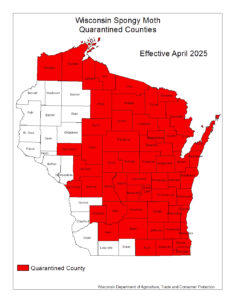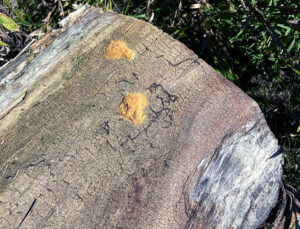
A spongy moth caterpillar consumes a leaf. / Photo Credit: Bill McNee, Wisconsin DNR
By Wisconsin Department of Natural Resources (DNR)
La Crosse County has become the latest Wisconsin location to be added to the state and federal spongy moth quarantine, joining most eastern and central Wisconsin counties already considered to be infested by the invasive insect.
The Wisconsin Department of Agriculture, Trade and Consumer Protection (DATCP) announced the change on April 1, based on trapping data collected last year.

An updated map of spongy moth quarantined counties in Wisconsin, showing the April 1 addition of La Crosse County to the quarantined list. / Map Credit: Wisconsin Department of Agriculture, Trade and Consumer Protection
With the announcement, 54 of Wisconsin’s 72 counties are now under quarantine status for spongy moth. High spongy moth populations are most likely to be seen within parts of the quarantined area, but may be present in non-quarantined counties.
Although the spongy moth outbreak of the last few years has declined or collapsed in most locations, pockets of high populations and tree defoliation may still exist this coming summer.
The spongy moth is an invasive pest that has been spreading westward since its introduction to North America from Europe in 1869. In Wisconsin, spongy moth caterpillars are generally active from mid to late April through July, depending on location and weather.
As the caterpillars grow, they feed on the leaves of more than 300 tree species and can cause complete defoliation of trees, contributing to eventual tree mortality. They then pupate and mate, with the females depositing lumpy, tan-colored egg masses that overwinter.
Placing a county under quarantine status activates regulations that have the greatest impact on plant nurseries, Christmas tree growers, loggers and sawmills, invoking inspection requirements and movement restrictions.
According to a DATCP news release, these businesses must enter into a compliance agreement with state or federal plant regulatory officials certifying that their nursery stock and wood products are free of spongy moth before the stock and products can be transported into non-quarantined counties or states.

Two spongy moth egg masses can clearly be seen on a piece of firewood at the Kettle Moraine State Forest – Southern Unit. Transporting firewood is a common way that spongy moth and other invasive insects spread to new locations. / Photo Credit: Bill McNee, Wisconsin DNR
In addition, individuals living in or visiting a quarantined county are urged to be diligent when transporting outdoor items. Spongy moths can deposit egg masses on just about any surface left outdoors, including firewood, lawn furniture, campers and boat trailers, allowing the eggs to be transported and infest a new location.
With each egg mass capable of holding up to 1,000 eggs, it’s important to inspect items before moving them between a home and recreational site, or a business headquarters and a work site.
For more information, visit the State of Wisconsin Spongy Moth Resource Center, the DNR spongy moth page, the DATCP spongy moth page and the United States Department of Agriculture spongy moth page.
